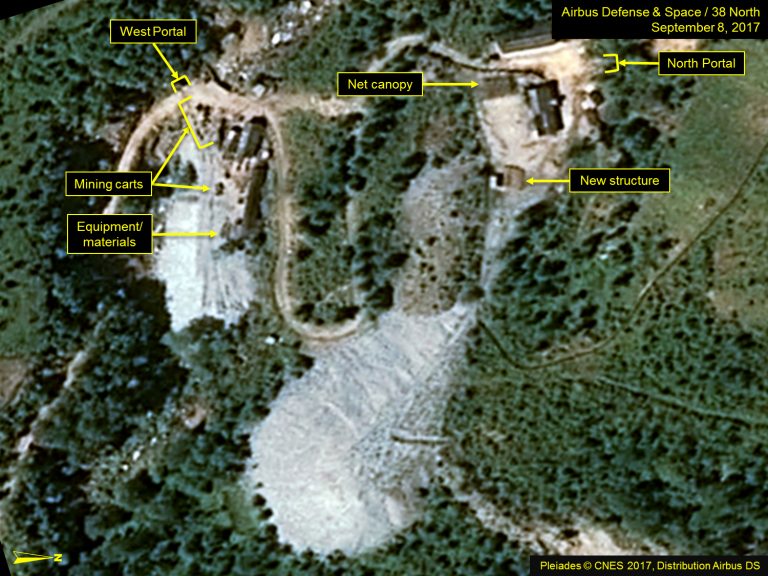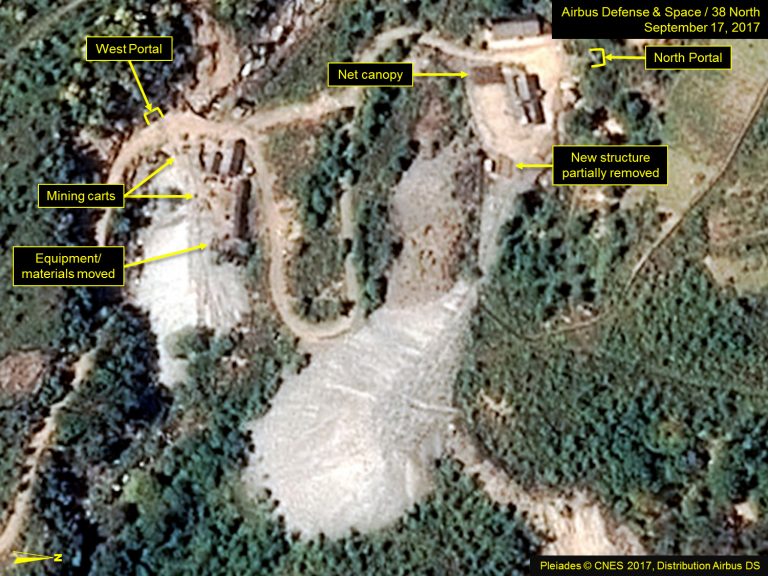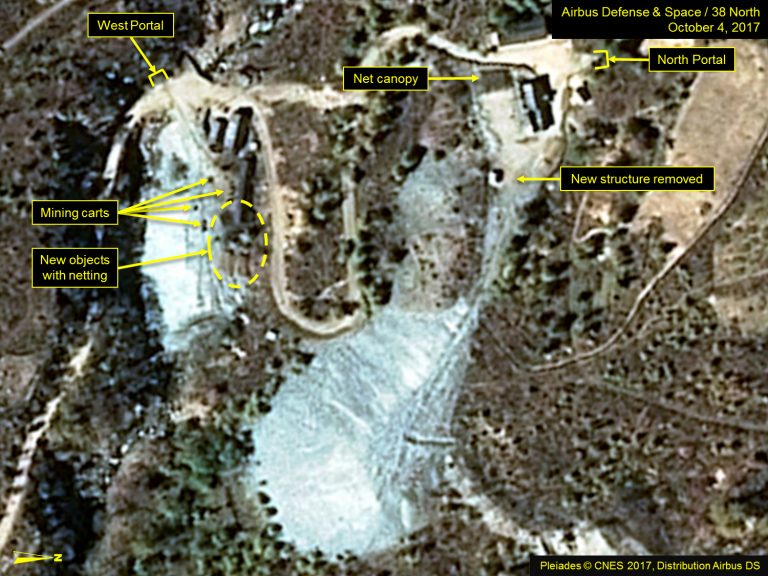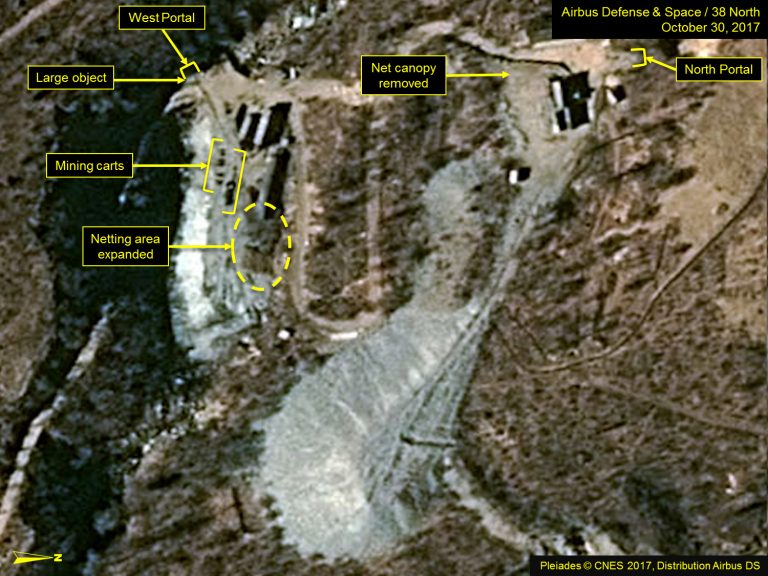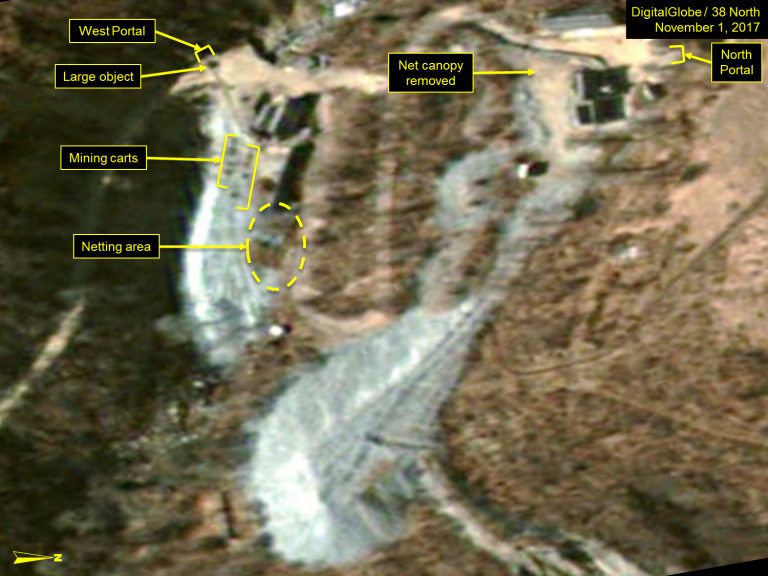North Korea’s Punggye-ri Nuclear Test Site: Focus Shifts to the West Portal
Overview
Commercial satellite imagery of the Punggye-ri Nuclear Test Site subsequent to North Korea’s sixth underground nuclear test shows significant movement of equipment, mining carts, material and netting within the area of the West Portal—a yet unused tunnel complex where little or no activity had been seen for the past several months. At the North Portal, where the last five of six nuclear tests were conducted, two temporary structures near the portal’s entrance that were likely associated with the September test have been removed, and no vehicles, mining equipment or materials have been observed in this area since the test. While it is not possible to determine the exact purpose of these activities from imagery alone, they could be associated with new nuclear test preparations at the West Portal, further maintenance on the West Portal in general and/or the abandonment of the North Portal.
Furthermore, a recent report by TV Asahi claimed hundreds of North Korean personnel had been trapped within collapsed tunnels at the test site cannot be corroborated with available commercial satellite imagery.[1] Significant movement of equipment and material has been observed near the West Portal since the most recent test, providing sufficient evidence that mining personnel have been inside the West Portal. But while the three most recent post-test tremors could have caused some damage to the tunnel networks, no observable signs of such a tunnel collapse or intensive rescue/recovery operations are visible outside any of the portals or within any of the support areas.
Post-Test Site Assessment
North Portal (Tunnel 2)[2]
The North Portal (See Figures 1-5), the tunnel complex that was used to conduct North Korea’s last five of six underground nuclear tests, shows no signs of new vehicle or equipment movement other than the removal of two small support structures. No new spoil is detectable on the portal’s spoil pile. The net canopy (located 40 meters south of the North Portal), which had been present for several months leading up to the latest test, was removed by October 30 along with any test related equipment that might have been stored underneath it. Another light framework structure (not present on imagery of September 1, but first noted on September 8) was likely constructed just prior to the test and employed in some fashion during the test, was also dismantled and removed by October 4.
West Portal (Tunnel 4)
No new spoil has been added to the spoil pile near the West Portal. The presence and movement of mining carts were noted in the days after the sixth test and have increased significantly in subsequent weeks. In addition, various pieces of equipment, material and netting have been moved into the area just north of the spoil pile where little or no such activity had been seen for months prior to the last test. This is consistent with recent reports citing the South Korean National Intelligence Service (NIS) as stating, “…construction had resumed at a fourth tunnel (West Portal), making it unable to be used ‘for a considerable amount of time.’” However, based on satellite imagery alone, we are unable to judge the readiness status of this tunnel for future underground nuclear testing as a substantial amount of spoil had already been removed prior to the latest test.
Figures 1-5. Imagery from September 8 to November 1 indicate limited movement and the removal of a net canopy by the North Portal. While no new spoil has been added near the West Portal, the presence and movement mining carts and equipment have significantly increased.
South Portal (Tunnel 3)
The South Portal (Figure 6) is currently in shadow. The only item of significance is a large white object, possibly a truck cab, near the secondary portal entrance. The NIS was reported as stating, “Tunnel 3 at the Punggye-ri test site is ready for a nuclear test ‘at any time.’ 38 North analysts have long reported that the tunnels served by the South Portal have been sufficiently prepared to accommodate a test at any time. We had also reported the appearance of a large tractor-trailer truck with a white cab parked near the portal five days after the most recent test.
Figure 6. While the South Portal is in shadow, a large white object is present near the secondary portal entrance.
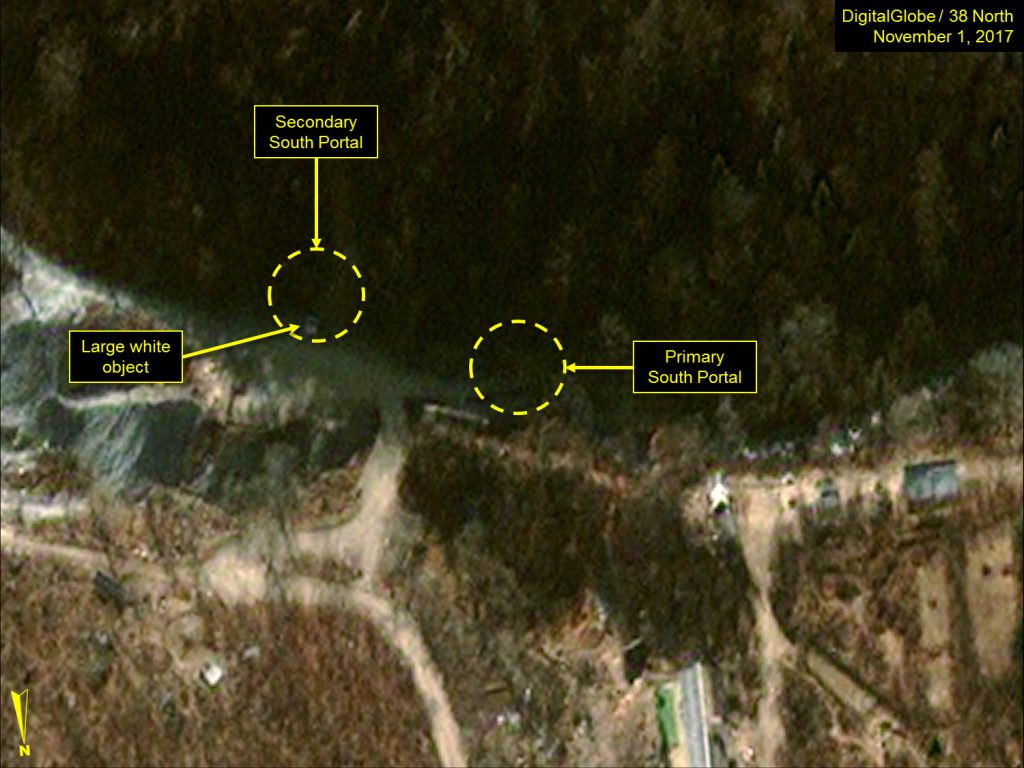
Main Administrative Area
The Main Administrative Area (Figure 7), located halfway between the North and South Portals, has appeared generally inactive since the test, although a few personnel and some small pieces of unidentified material have been observed in the general area on different images.
Figure 7. The Main Administrative Area has overall appeared inactive since the September nuclear test.
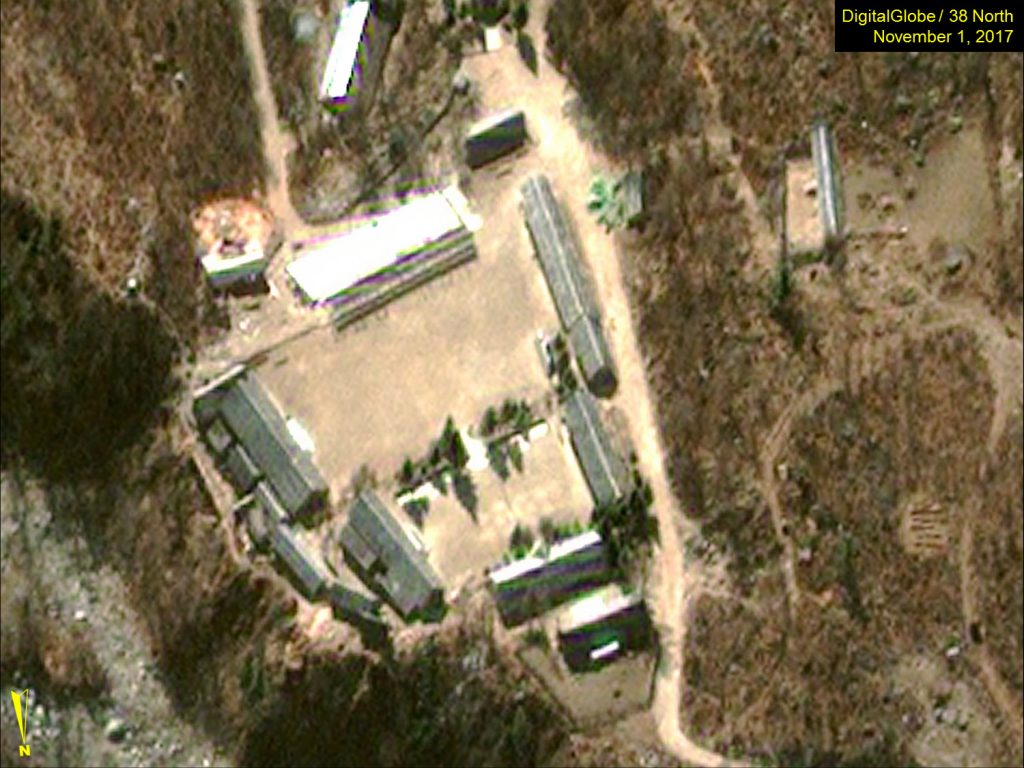
Command Center Area and Guard Barracks
The Command Center Area (Figure 8) has also appeared generally quiet except for the presence of one vehicle under the parking shelter on September 8. What appears to be a covered stack of materials or a new possible small shed is visible on the more recent imagery of the adjacent support area.
Figure 8. Covered stack of materials or new structure observed at the support area.
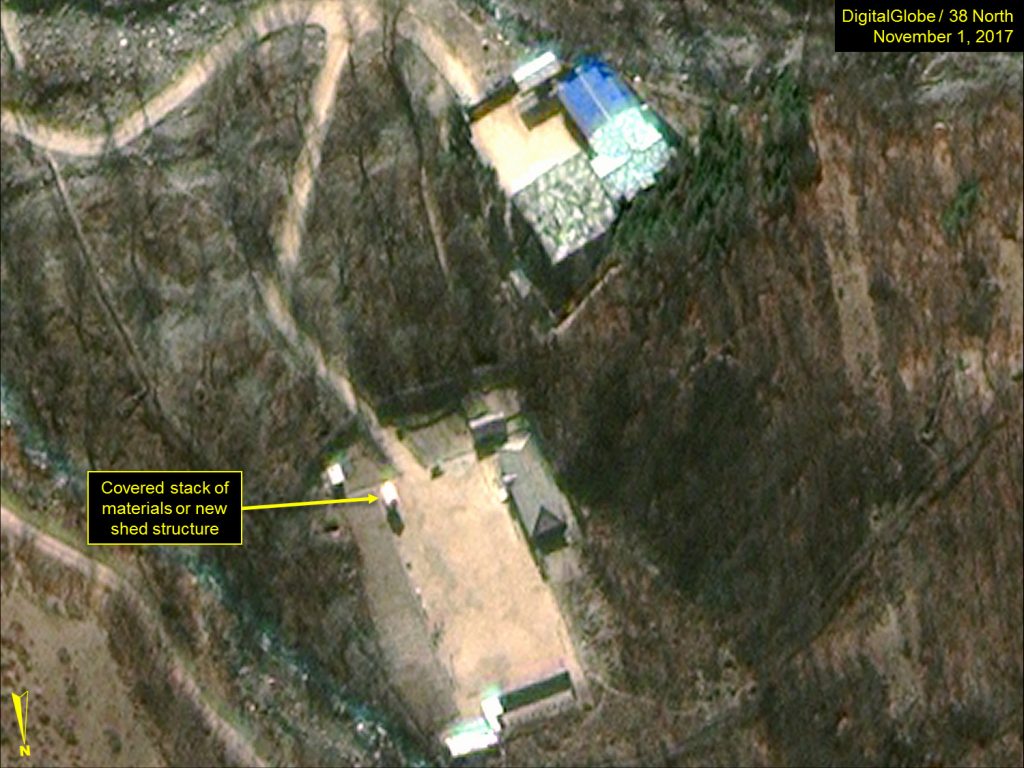
The Guard Barracks Area
The Guard Barracks Area (Figure 9) shows the courtyard full of what appear to be personnel, stacks of grain and maybe pallets of equipment. A new shed-type structure has been built behind the barracks within the last month.
Figure 9. New structure built behind the guard barracks and several personnel and/or objects present in the courtyard.
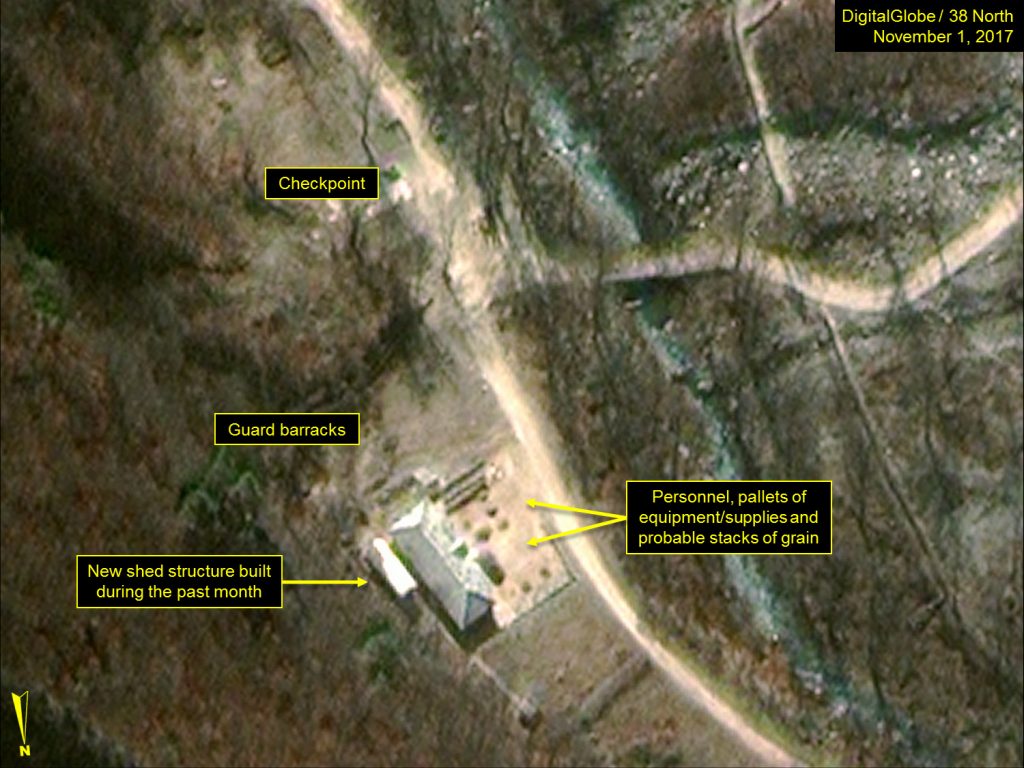
Southern Support Area
The Southern Support Area (Figure 10) near the Command Center has what appear to be very neatly aligned rows of something—likely personnel or stacks of grain—but the resolution is insufficient to draw a definitive conclusion.
Figure 10. Neatly aligned objects or personnel present at the Southern Support Area.
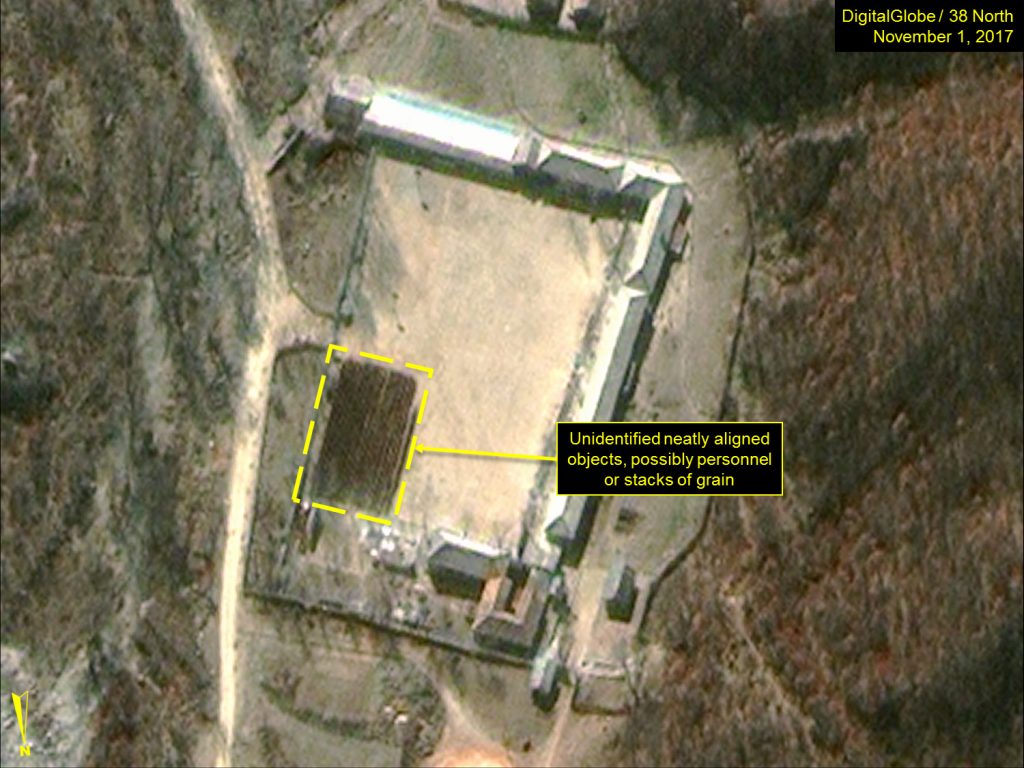
Report of Collapsed Tunnels Cannot be Corroborated
Recently, TV Asahi (quoting an unnamed source) reported that around 100 people were buried during the construction of an underground test tunnel at the Punggye-ri Nuclear Test Site, when the tunnel collapsed. More than 100 people were then reportedly buried during the rescue effort, when another collapse occurred.
There were no reports of seismically detected tremors on or around September 10, and no commercial satellite imagery was available (due to cloudy weather conditions) from September 8-17 to help identify signs of either collapse or a rescue effort. As such, based on imagery alone, we can neither confirm any tunnel collapses nor observe any evidence of rescue attempts subsequent to the latest test.
Implications
While it is possible that the North Portal has been at least temporarily abandoned in the aftermath of the September 3 nuclear test, the overall Punggye-ri Nuclear Test Site is neither abandoned nor mothballed. Significant tunnel related operations continue at the West Portal, while the South Portal remains in a continuing state of nuclear test readiness.
- [1]
This assertion was refuted through a commentary in North Korean media. See “Japan TV Asahi Blasted for Releasing Misinformation about DPRK: KCNA Commentary,” KCNA, November 2, 2017.
- [2]
Tunnel 1, refers to the East Portal, where North Korea tested its first nuclear device in 2006 but since abandoned. Tunnel 2 refers to the North Portal, where the last five tests have been conducted. Tunnel 3 refers to the South Portal as yet unused for testing purposes; and Tunnel 4 refers to the West Portal, which is the last of the tunnels to have been excavated.

